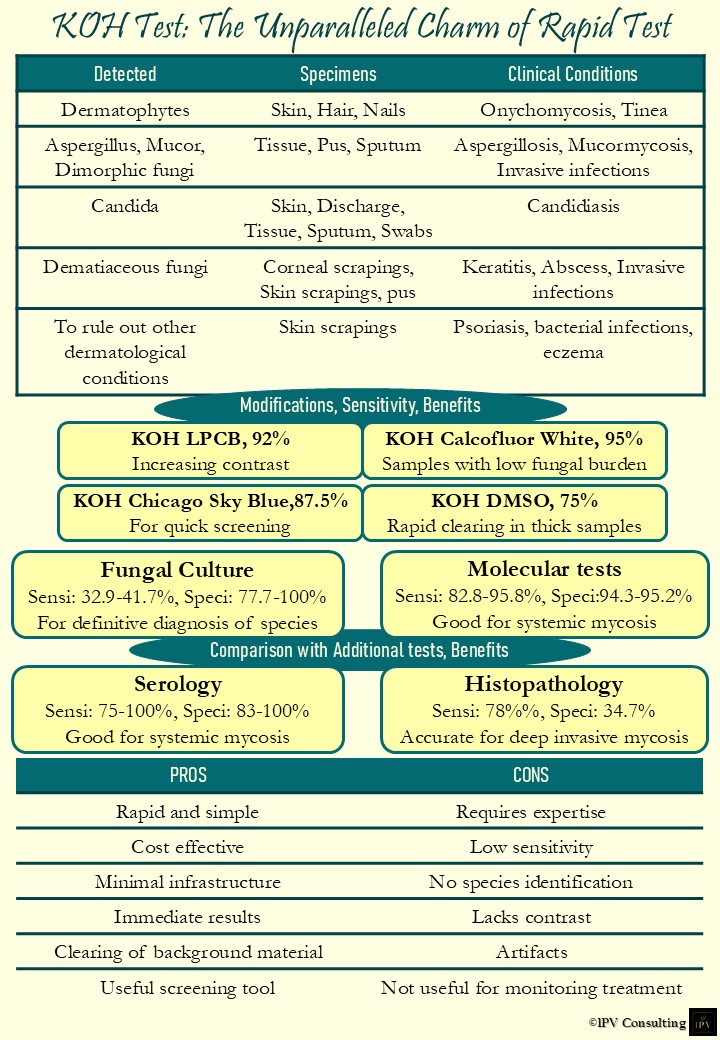KOH Test: The Unparalleled Charm of Rapid Test
An inorganic substance known for its keratolytic properties in the field of fungal diagnostics is potassium hydroxide (KOH). The KOH wet mount is a useful, quick and affordable screening method for identifying fungal infections in clinical settings.
Worldwide, the prevalence of fungal infections is increasing. The preliminary identification of fungal genera in KOH wet mount guides the physicians for further diagnostic workup. As it offers fast results in emergency rooms, primary care and dermatology settings, the timely start of antifungal treatment is possible when clinical suspicion is strong.
Several studies have compared the effectiveness and application of KOH test with other diagnostic methods. For the majority of fungal diseases, fungal culture is considered the gold standard for speciation. A quick and affordable way to provide a tentative diagnosis of an invasive fungal infection is through histopathology. Molecular tests and serological tests have greater sensitivity and specificity for invasive and certain systemic fungal diseases but they are more expensive and less accessible. So, the simplest and cost-effective method for diagnosing fungal infections is direct microscopy of the samples. Additionally, integrating the several methods always helps to improve the diagnostic accuracy.
Numerous modifications of the conventional KOH test have been developed to improve the sensitivity, specificity and speed of diagnosing fungi in clinical samples. These modifications expand the utility of the KOH test, making it more adaptable and effective for diagnosing a wide range of superficial and deep fungal infections in various clinical settings.
As no single test is perfect, the highest diagnostic yield for fungal infections can be achieved by combining direct microscopy KOH, culture and advanced techniques. Despite drawbacks, the classic KOH wet mount test continues to be the fundamental test for preliminary diagnosis and consistently demonstrating its unparalleled charm in the modern automated settings.
References
1. Al Dhafiri M, Alhamed AS, Aljughayman MA, Bin Sifran KF, Al Furaikh BF, Alosaif N. Use of Potassium Hydroxide in Dermatology Daily Practice: A Local Study From Saudi Arabia. Cureus. 2022;14(10):e30612.
2. Warnnissorn P, Sawatdiwithayayong J, Surit P. Efficacy and Rapidity of Potassium Hydroxide Mount and Modified Chicago Sky Blue 6B Stain with Potassium Hydroxide in Fungal Keratitis Detection. Korean J Ophthalmol. 2024;38(2):98-104.
3. Levitt JO, Levitt BH, Akhavan A, Yanofsky H. The sensitivity and specificity of potassium hydroxide smear and fungal culture relative to clinical assessment in the evaluation of tinea pedis: a pooled analysis. Dermatol Res Pract. 2010;764843.
4. Manjyot G et al. Comparative Evaluation of Potassium Hydroxide Mount, Fungal Culture, and Histopathology of Nail Clipping with Periodic Acid–Schiff Stain in the Diagnosis of Onychomycosis. Indian Journal of Dermatopathology and Diagnostic Dermatology 2021;8(1):6-12.
5. Baker J, Denning DW. The SSS revolution in fungal diagnostics: speed, simplicity and sensitivity. Br Med Bull. 2023;147(1):62-78.
6. Lass-Flörl C, Mutschlechner W, Aigner M, et al. Utility of PCR in diagnosis of invasive fungal infections: real-life data from a multicenter study. J Clin Microbiol. 2013;51(3):863-868.
7. Koh XQ, Han H, Shen L, Chandran NS. Retrospective Investigation of the Utility of Potassium Hydroxide Smear in the Diagnosis and Management of Cutaneous Fungal Infections by Dermatologists. Indian J Dermatol. 2024;69(6):453-460.






